
- text size
- Enlarge Text Size
- Shrinking font size
Nampo ~ Jungang-dong
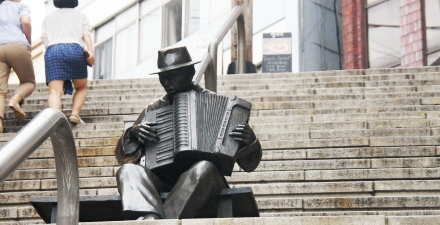
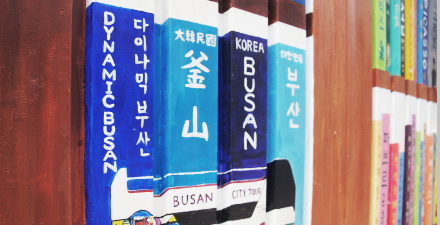
Jungang-dong is called the ‘original downtown’, because the city started from here when it was just beginning. Due to the international ocean terminal in the port of Jungang-dong, tourists and Russian merchants get off here. They begin their trip from Jungang-dong to outside of the original town, and we come into the original town and walk around Jungang-dong and Nampo-dong. As the ship is an older transportation than the train, the first stranger who reached Busan might have put his first step in Jungang-dong.
There are still many trading companies and printing shops. The noonday Jungang-dong streets are full of office workers coming out of the company for lunch. It is also very famous for the cheap but good restaurants, because bad ones can never survive in Jungang-dong due to word-of-mouth. Streets are full of all kinds of restaurants, and you cannot miss the small pubs for Soju or Cheongju.
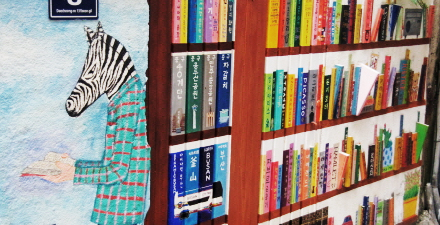
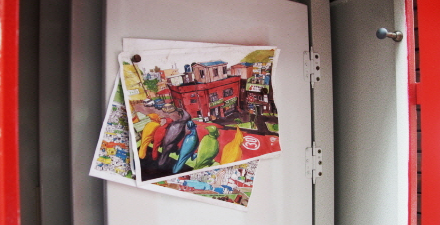
The 40 stairs are in the center of Jungang-dong. Walking in between company building from Jungang-dong station and going up the 40 stairs, you will see the Printing Alley. It means that the number of stairs connecting the two streets is 40 approximately. The stairs became famous as the filming spot of the movie . The stairs had been originally the center of the commercial area since the Korean War because it was a path to go to the old Busan station before it was destroyed by fire.
As the members from TV program played the show-throwing game, the number of tourist has increased. It is said that the artists from the cultural and artistic place of the original town, ‘Totatoga’, shouted ‘Baeshin(betrayal) baeshin bae-ae-shin’ for Lee Gwang Soo when he threw his sneaker over the stairs.
The Printing Alley starting from the top of the stairs is a wall painting street. There were technicians to fill metal type blocks to every printing machine before the digital printing method was invented. For every page, they had to pu the small blocks on a board. The faster and more precisely they did the printing, the more professional they were. Even though they are gone now, still the printing alley is boisterous with thousands of books printed every day. There is an endless sound of printers running on the Printing Alley full of smell of ink. It is quite interesting to see the wall paintings on every empty wall.
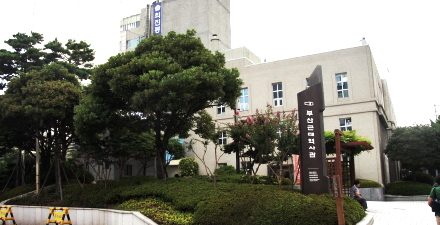
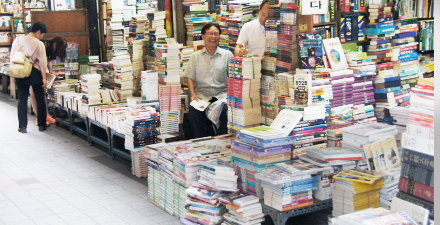
Getting out of the Printing Alley toward Yongdusan mountain, you will meet Busan Modern History Museum in 10 minutes on foot. Whether it is Nampo-dong course or Jagalchi course, you cannot miss Busan Modern History Museum. It is difficult to find a public restroom in this area, but the museum has a clean restroom with the door you can directly go into without passing through the robby. For the elderly who have come back to Busan from other areas, the museum is even more special because the streets they once walked on are reproduced as they were before. You can see the pictures of the old downtowns in Busan as there are the pictures of the modern materials you can hardly find in somewhere else.
lJungang-dong, Nampo-dong and Bosu-dong are neighbors, separated by one street each, so it is not difficult to visit Bosu-dong Book Alley from Busan Modern History Museum. This used book alley that has been maintained for decades is always crowded both in weekdays and weekends with customers looking for books. Those looking for used books are particularly prudent. Some find an out-of-print book, and some buy a new book at a cheap price. Since a lot of best sellers and reference books are resold, you can get quite famous books on this street at once. They are as good as new ones as they are well preserved. The high school students few decades ago asked their parents for money to buy reference books, bought them here at cheaper price, then ate some snacks with the money left. What a perfect crime.

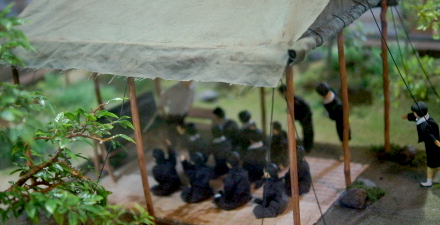
The last day of the course is Provisional Capital Memorial Hall. You’ve walked to Toseong station after getting off at Jungang-station. It’s not that far. During the period Busan was the provisional capital of Korea, the Korean War, this place played a role as the provisional government. The president Lee Syngman stayed here. This building has the modern style of architecture built in Japanese colonial era, which means it has western style building and Japanese structure with Korean life style. From old times, students living near here came to the hall, whose structure makes it cool in here, and read books or did their homework lying facing down on the floor. Nampo-dong and Jungang-dong where you can leave for time travel. This course completed with this usual building will take you back to the past with the power of this place.

(47353) 20, Jungang-daero 644beon-gil, Busanjin-gu, Busan, Republic of Korea Tel : 1544-5005
Copyright (C) 2015 Busan Transportation Corporation. All Rights Reserved.
 TOP
TOP




